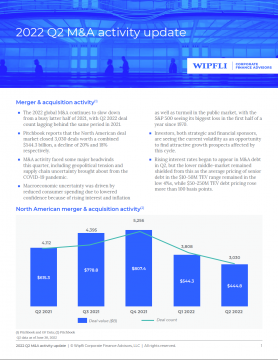Junior Capital: The Window Is Wide Open
Please be aware: More recent data has been published since the time of this post. To see current market trends, check out the most recent issues of Market Updates.
Junior third-party capital—either subordinated (also known as mezzanine) debt or institutional equity—can be useful to companies in a variety of ways. It can play an important part in creating value for existing shareholders, whether a company is looking to grow aggressively, its owners are seeking liquidity, or a company is pursuing a simple arbitrage scenario because of a low cost-of-capital environment. Here’s how junior capital provides benefits in each of these circumstances:
- Aggressive growth. The issuer has an opportunity to grow its cash flow and equity value through a strategic acquisition or by organic growth (a plant expansion, bulk personnel expansion, etc.). Senior lenders, however, are unable to provide the funds necessary to execute the growth because of lending constraints. In many cases, subordinated debt investors and institutional equity investors can provide the funding needed to pursue growth plans and complete expansions.
- Owner liquidity. Existing shareholders are seeking liquidity for a portion of their investment in a private company via a dividend recapitalization or cash-out financing. However, senior lenders cannot provide the full amount of the funds. Depending on the amount desired, borrowing subordinated debt, partnering with a minority equity investor, or selling a majority stake to an institutional equity investor can achieve this goal.
- Arbitrage low cost of capital. Today’s investing environment is competitive, with subordinated debt investors and institutional equity investors aggressively seeking to invest in quality issuers. This creates opportunities where subordinated debt rates are historically low and institutional equity valuations are historically high. But these opportunities open and close like windows (e.g., the window was closed for most of 2008 through 2010). It may be prudent for shareholders to review their current options to maximize value today.
Clearly, junior capital can bridge the financing gap, but it is important to recognize the differences between the available sources.
Subordinated (Mezzanine) Debt
Mezzanine debt is a loan that takes a junior position in the company’s collateral behind traditional bank financing and therefore is referred to as subordinated debt. In the lower middle market, it typically has a second lien on all collateral of the company and carries payment and action subordination to the bank in a default scenario.
Mezzanine debt is often used to fund LBOs, recapitalizations, add-on acquisitions, or company growth. Typical terms include:
- Closing Fee
- Current pay interest portion.
- Yield enhancement (deferred interest, warrants, and/or equity coinvestment).
- Three- to seven-year term.
- No amortization of the principal throughout the term.
- Board observation rights, but typically no board seats (passive capital).
According to Pepperdine Private Capital Markets Project, 2013 Capital Markets Report, median required rates of returns (current pay interest portion plus yield enhancement) for mezzanine debt are as follows:
These rates vary substantially depending on the quality of the issuer and the skill of the corporate finance advisor. For example, one of Wipfli Corporate Finance Advisors’ pending mezzanine transactions is a $3 million issuance with a proposed 12% current interest portion and a 2.5% deferred interest portion, for a total rate of return of 14.5% (versus a median 22.0% in the Pepperdine study).
Institutional Equity
Institutional equity is a cash infusion in exchange for a minority or majority equity interest in a company. Institutional equity differs from equity raised from individual investors, primarily in the amount, terms, hold period, due diligence requirements, and potential post-close strategic benefits. Typically, an issuer has a trade-off between the level of due diligence institutional investors require and the increased amount of funds available, attractive terms, and post-close benefits.
Sources of institutional equity include private equity groups, family offices, and hedge funds. Depending on the amount of capital required and the company’s equity valuation, the investment will be in the form of either a minority equity or a majority equity stake. This differentiation impacts the general terms, valuation, and universe of potential investors. 
Like mezzanine debt, institutional equity is typically used to fund LBOs, recapitalizations, add-on acquisitions, or company growth. Institutional equity investors typically target a required rate of return of 20%-30%; however, the amount depends on the size of the company, the quality of the issuer, and the skill of the company’s corporate finance advisor.
Consider this example of a majority recapitalization. In this scenario, the existing shareholders sell 80% of their equity stake to an institutional equity investor, allowing the shareholders to monetize a portion of their ownership while retaining upside participation in the growth of the business and partnering with a group that may provide post-close strategic benefits to accelerate the company’s growth. Ultimately the shareholders achieve a significant return on their ownership while diversifying their risk in the interim.
*Assumptions: 1) Company has no debt prior to close of 80% sale. 2) Company pays down debt during five year hold period, so no debt at close of second sale.
Opportunity for Middle Markets
Junior capital, if employed correctly, can significantly enhance value for existing shareholders. The current environment for junior capital is very attractive to issuers, and a window has opened for shareholders to take advantage of these conditions. The assistance of skilled corporate finance advisors is important not only in identifying and securing the best investment terms, but also in assessing the appropriate amount of capital and devising optimal use of proceeds strategies. The benefits are clear, the appeal is obvious, and the opportunity is here. Junior capital can be a useful and vital source of capital.
Looking to be more acquisitive?
Having an acquisition plan is critical. Start yours now.
Get the checklist now
Categories
Read all Market Updates and Insights
A quarterly, insightful look at middle-market merger and acquisition activity.
Thought-provoking articles on value, growth, and strategy, merger and acquisition news, research and analysis from WCF consultants.





